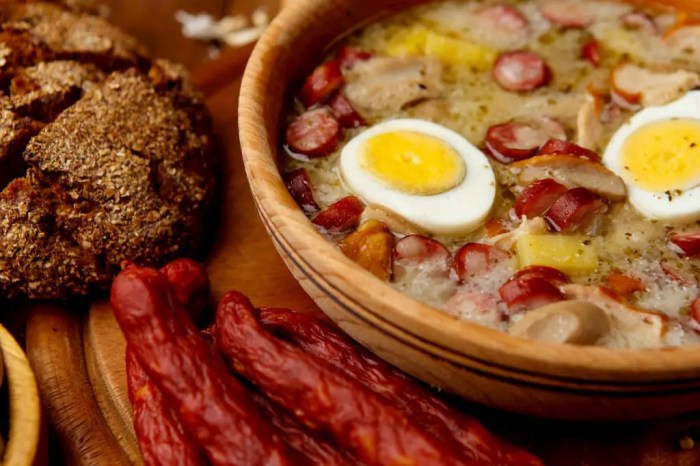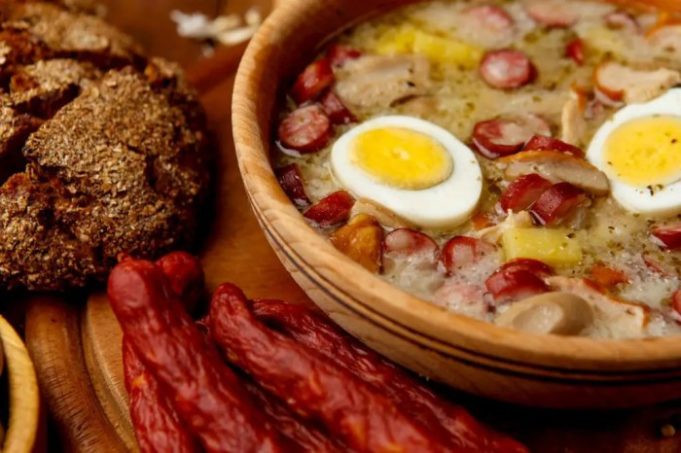The Polish diet, a vibrant tapestry woven with centuries of history and cultural influences, offers a tantalizing glimpse into the heart of Polish life. From hearty stews and savory dumplings to sweet pastries and refreshing beverages, Polish cuisine reflects the country’s rich agricultural heritage and enduring culinary traditions.
This article delves into the fascinating world of the Polish diet, exploring its historical roots, nutritional composition, and the unique flavors that have captivated generations. We’ll uncover the secrets behind iconic Polish dishes, delve into the health implications of this traditional cuisine, and discover the modern trends that are shaping the future of Polish culinary arts.
Popular Polish Dishes
Polish cuisine is known for its hearty, flavorful dishes that often feature traditional ingredients like potatoes, meat, and cabbage. These dishes are a testament to the country’s rich history and cultural heritage, passed down through generations.
Popular Polish Dishes
Polish cuisine offers a diverse range of dishes, each with its own unique flavor profile and cultural significance. Here is a table showcasing some of the most popular Polish dishes, their ingredients, preparation methods, and cultural significance:
| Dish Name | Ingredients | Preparation Method | Cultural Significance |
|---|---|---|---|
| Pierogi | Potato, cheese, sauerkraut, meat, mushrooms, onions, dough | Boiled or fried dumplings filled with various savory or sweet fillings | A national dish of Poland, often served as a main course or appetizer. They are traditionally made at home and enjoyed during holidays and special occasions. |
| Bigos | Sauerkraut, cabbage, various meats (pork, sausage, beef), mushrooms, onions, garlic, spices | A hearty stew simmered for hours, often served with bread or potatoes. | A traditional Polish dish that has been enjoyed for centuries. It is often served during winter months and is considered a comfort food. |
| Kielbasa | Pork, beef, spices, seasonings | Smoked or fresh sausage, often served grilled, fried, or boiled. | A popular Polish sausage that is enjoyed in many different forms. It is often served as a main course or as part of a larger meal. |
| Zurek | Sour rye soup, sausage, potato, egg, vegetables | A thick, sour soup made with fermented rye flour, often served with sausage, potato, egg, and vegetables. | A traditional Polish soup that is often enjoyed during Easter. It is considered a comfort food and is known for its unique flavor. |
| Gołąbki | Cabbage leaves, meat filling (pork, beef, rice), tomato sauce | Stuffed cabbage rolls simmered in tomato sauce, often served with mashed potatoes or rice. | A traditional Polish dish that is often served during holidays and special occasions. They are considered a comfort food and are known for their rich flavor. |
Iconic Polish Dishes
Pierogi
Pierogi are a type of Polish dumpling, typically made from unleavened dough and filled with various savory or sweet ingredients. They are boiled or fried and are often served with butter, sour cream, or fried onions. The most common fillings include potato and cheese, sauerkraut and mushrooms, and meat. Pierogi are a staple of Polish cuisine and are often enjoyed during holidays and special occasions. They are a symbol of Polish hospitality and are often shared with family and friends.
Bigos
Bigos is a hearty Polish stew made with sauerkraut, cabbage, various meats (pork, sausage, beef), mushrooms, onions, garlic, and spices. It is a slow-cooked dish that is traditionally simmered for hours, allowing the flavors to meld together. Bigos is often served with bread or potatoes and is considered a comfort food in Poland. It is a dish that is often enjoyed during the winter months, when its warmth and richness are particularly appreciated.
Kielbasa
Kielbasa is a type of Polish sausage that is made from pork, beef, spices, and seasonings. It is often smoked or fresh and is served grilled, fried, or boiled. Kielbasa is a versatile ingredient that can be used in many different dishes, including soups, stews, and sandwiches. It is a popular ingredient in Polish cuisine and is often enjoyed as a main course or as part of a larger meal.
The Polish Diet and Health

The Polish diet, like any other, has both positive and negative health implications. It’s a complex interplay of traditional food choices, modern influences, and individual lifestyle factors. While it can offer certain nutritional benefits, it’s important to understand its potential downsides and how to achieve a balanced approach.
The Polish Diet and Chronic Diseases
Research suggests a connection between the Polish diet and the prevalence of certain chronic diseases. While the exact nature of this relationship is complex and influenced by various factors, studies have highlighted some notable points.
Heart Disease
The traditional Polish diet, rich in animal fats and saturated fatty acids, has been linked to an increased risk of heart disease. However, modern dietary changes, including a greater emphasis on fruits, vegetables, and whole grains, have led to a decrease in heart disease rates in recent years.
Diabetes
The consumption of processed foods, sugary drinks, and refined carbohydrates in the Polish diet has contributed to rising rates of type 2 diabetes. This trend is consistent with global observations where dietary changes driven by modernization and urbanization have contributed to increased diabetes prevalence.
Obesity
The Polish diet, particularly in urban areas, has seen a shift towards higher calorie intake, leading to an increase in obesity rates. This is partly attributed to the availability of processed foods, fast food, and larger portion sizes.
Positive Aspects of the Polish Diet
Despite potential drawbacks, the Polish diet also offers positive aspects that contribute to overall well-being and longevity.
High Fiber Content
Traditional Polish cuisine emphasizes whole grains, legumes, and vegetables, leading to a high fiber intake. This promotes digestive health, regulates blood sugar levels, and may reduce the risk of certain cancers.
Rich in Vitamins and Minerals
The Polish diet is rich in various vitamins and minerals, including vitamin C from fruits and vegetables, vitamin D from dairy products, and iron from meat and legumes. These nutrients are crucial for maintaining immune function, bone health, and overall vitality.
Cultural Significance
Food plays a central role in Polish culture, fostering social connections and traditions. Family meals and celebrations often involve shared dishes, promoting a sense of community and well-being.
Balancing the Polish Diet for Health
Achieving a balanced and healthy Polish diet requires mindful choices and an understanding of both its strengths and weaknesses.
Moderation and Variety
It’s important to consume traditional Polish dishes in moderation and diversify the diet with a wider range of foods. This includes incorporating more fruits, vegetables, and whole grains while limiting processed foods, sugary drinks, and saturated fats.
Active Lifestyle
Regular physical activity is crucial for maintaining a healthy weight, managing chronic diseases, and enhancing overall well-being. Engaging in regular exercise, even moderate levels, can help offset the potential negative health effects of a less-than-ideal diet.
Personalized Approach
Ultimately, a healthy Polish diet is one that caters to individual needs and preferences. Consulting a healthcare professional or registered dietitian can provide personalized advice based on individual health goals and dietary requirements.
Summary
The Polish diet is more than just a collection of recipes; it’s a cultural treasure trove that speaks to the resilience, resourcefulness, and culinary artistry of the Polish people. As we’ve journeyed through the historical and modern facets of this fascinating cuisine, we’ve discovered the enduring power of tradition, the allure of bold flavors, and the ever-evolving landscape of Polish culinary innovation. Whether you’re a seasoned foodie or a curious newcomer, the Polish diet promises a flavorful adventure that will leave you wanting more.
Commonly Asked Questions
What are some of the most popular Polish dishes?
Some of the most popular Polish dishes include pierogi (dumplings), bigos (hunter’s stew), kielbasa (sausage), gołąbki (stuffed cabbage rolls), and żurek (sour rye soup).
Is the Polish diet considered healthy?
The Polish diet can be considered healthy, as it is rich in fresh vegetables, fruits, and whole grains. However, it’s important to note that some traditional Polish dishes can be high in fat and salt.
What are some of the modern trends in Polish cuisine?
Modern trends in Polish cuisine include a focus on fresh, local ingredients, the incorporation of international flavors, and the rise of vegetarian and vegan options.
The Polish diet, with its emphasis on fresh produce, lean proteins, and whole grains, is known for its heartiness and delicious flavors. But when it comes to overall health, the best diet is one that’s tailored to your individual needs and preferences.
What is the best diet for overall health is a question that can be answered by consulting a healthcare professional, but focusing on a balanced approach with plenty of fruits, vegetables, and whole grains is a great start. The Polish diet, with its focus on fresh ingredients, can be a good foundation for a healthy lifestyle.
The Polish diet is known for its hearty and flavorful dishes, often featuring fresh ingredients and traditional recipes. It’s a great example of how cultural cuisine can be both delicious and healthy. But when it comes to finding the best diet for you, it’s essential to consider your individual needs and goals.
You can explore the vast world of diets and find what works best for you by checking out this resource on what is the best diet to go on. Whether you’re interested in the Polish diet or something else entirely, remember to prioritize balanced nutrition and sustainable habits for long-term well-being.
The Polish diet, known for its hearty soups and flavorful meats, can be a delicious way to experience Eastern European cuisine. However, before embarking on any new dietary journey, it’s important to prepare your body for the transition. A before diet detox can help cleanse your system and make it easier to adapt to the changes in your eating habits.
Whether you’re trying a Polish diet or another type of dietary approach, taking the time to detox beforehand can make the process smoother and more enjoyable.
























